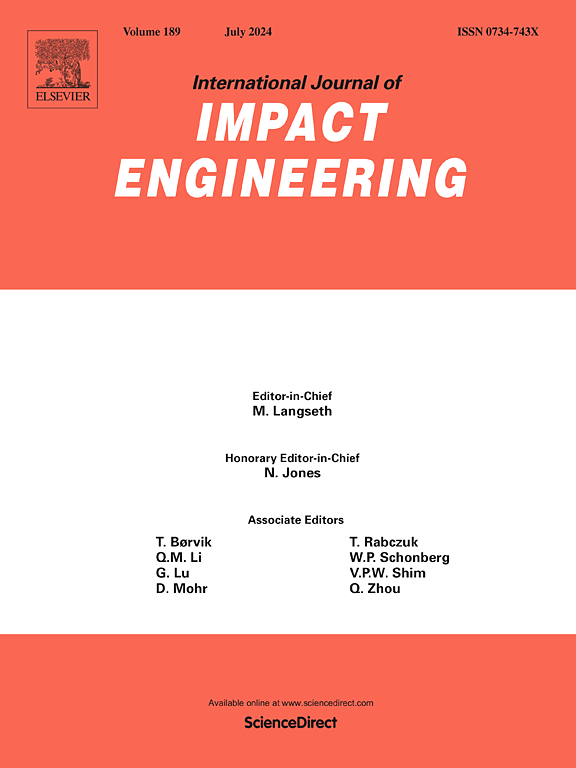Dimensional analysis and scalability of a simplified hull girder subjected to underwater explosion shock loading
IF 5.1
2区 工程技术
Q1 ENGINEERING, MECHANICAL
International Journal of Impact Engineering
Pub Date : 2025-04-01
DOI:10.1016/j.ijimpeng.2025.105332
引用次数: 0
Abstract
Conducting full-scale experiments on naval structures subjected to underwater explosions (UNDEX) is generally impractical, leading to the employment of small-scale models. This requires the existence of scaling laws that relate the behaviour of the full-scale structure to the prototype. However, the derivation of scaling laws for impact problems is hindered by the distortion induced by strain rate effects, and scholars in the last 20 years have focused on developing correction methodologies. However, their application to naval structures remains unexplored. This work examines the interaction between the primary shock of a UNDEX and the structural response, focusing on the scalability of a steel Simplified Hull Girder (SHG). The investigation is based on numerical simulations carried out using the Coupled Eulerian–Lagrangian framework, and is demonstrated against an experimentally validated case study. In the selected scenario, the SHG prototype undergoes hogging damage. The response of small-scale models with scaling factors of 1/2, 1/10, 1/20, 1/50, 1/80, and 1/100 is investigated, revealing distortions caused by strain rate effects. A correction strategy based on the joint or exclusive modification of the explosive mass and the material’s static yield strength is employed to compensate for these effects, yielding satisfactory results. Unlike existing studies, which often focus on single damaged configurations, this work emphasises the time-dependent structural response, analysing the hogging motion of the SHG and the influence of the correction strategy over time. The proposed approach demonstrates the effectiveness of the correction procedure in the largely unexplored naval domain and contributes to the development of general scaling laws for structural impact problems.
承受水下爆炸冲击载荷的简化船体大梁的尺寸分析和可扩展性
对遭受水下爆炸(UNDEX)的舰船结构进行全尺寸实验通常是不切实际的,因此需要使用小尺寸模型。这就要求存在将全尺寸结构的行为与原型联系起来的比例法则。然而,应变率效应引起的变形阻碍了冲击问题比例定律的推导,过去 20 年来,学者们一直致力于开发校正方法。然而,这些方法在舰船结构中的应用仍有待探索。本研究以钢制简化船体大梁(SHG)的可扩展性为重点,探讨了 UNDEX 一次冲击与结构响应之间的相互作用。研究基于欧拉-拉格朗日耦合框架进行的数值模拟,并通过实验验证的案例研究进行了论证。在选定的场景中,SHG 原型发生了曳引损伤。研究了缩放因子为 1/2、1/10、1/20、1/50、1/80 和 1/100 的小规模模型的响应,揭示了应变率效应引起的变形。为了补偿这些影响,采用了一种基于爆炸质量和材料静态屈服强度的联合或单独修正策略,取得了令人满意的结果。现有的研究通常侧重于单一的损坏配置,与此不同的是,本研究强调随时间变化的结构响应,分析了 SHG 的曳引运动和修正策略随时间变化的影响。所提出的方法证明了校正程序在基本未开发的海军领域的有效性,并有助于为结构撞击问题开发通用缩放定律。
本文章由计算机程序翻译,如有差异,请以英文原文为准。
求助全文
约1分钟内获得全文
求助全文
来源期刊

International Journal of Impact Engineering
工程技术-工程:机械
CiteScore
8.70
自引率
13.70%
发文量
241
审稿时长
52 days
期刊介绍:
The International Journal of Impact Engineering, established in 1983 publishes original research findings related to the response of structures, components and materials subjected to impact, blast and high-rate loading. Areas relevant to the journal encompass the following general topics and those associated with them:
-Behaviour and failure of structures and materials under impact and blast loading
-Systems for protection and absorption of impact and blast loading
-Terminal ballistics
-Dynamic behaviour and failure of materials including plasticity and fracture
-Stress waves
-Structural crashworthiness
-High-rate mechanical and forming processes
-Impact, blast and high-rate loading/measurement techniques and their applications
 求助内容:
求助内容: 应助结果提醒方式:
应助结果提醒方式:


